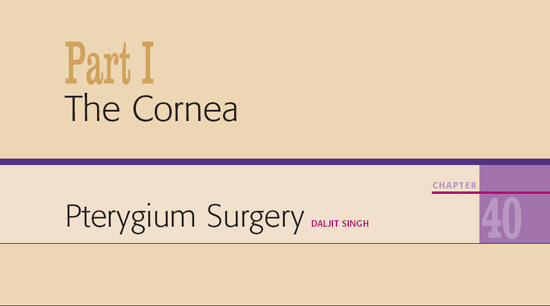
 he pterygium may be operated on in many ways, but in each case, it must be removed from its bed and excised. Recurrent pterygia are more difficult to treat because of the extensive scar tissue that is firmly rooted in the sclera. In recurrent cases, the involved corneal tissue is also firmly attached to the thick scar tissue.
he pterygium may be operated on in many ways, but in each case, it must be removed from its bed and excised. Recurrent pterygia are more difficult to treat because of the extensive scar tissue that is firmly rooted in the sclera. In recurrent cases, the involved corneal tissue is also firmly attached to the thick scar tissue.
In the “bare sclera” technique for pterygium surgery the cornea should be fully cleared of the pterygium, and no raised area should be near the limbus for a distance of 3 to 5 mm. I have been using this technique for most of my surgical career.
Whenever tissue must be removed, the question arises whether it should be removed with the standard forceps scissors and bipolar tools or the new ablative tool, the Fugo blade. For a while I used the Fugo blade to assist in removing excessive scar tissue during a mainly manual excision of the pterygium. Gradually, however, my technique for pterygium removal has increasingly involved use of the Fugo blade. A description follows.
TECHNIQUE
Anesthesia
Provide surface anesthesia with 2% lidocaine.
Surgical Technique
- Open the conjunctiva with a 100-µm Fugo blade tip, near the upper edge of the pterygium, about 1 mm from the limbus. To minimize the risk of subconjunctival bleeding, do not use a needle. Instead, inject lignocaine through the opening under the conjunctiva with a 30-gauge cannula. Advance the cannula toward the lower edge of the pterygium, where it is used to lift the conjunctiva. Some subconjunctival bleeding may be seen as the blunt cannula is advanced (Fig. 40.1).
- Touch a 600-µm Fugo blade tip to the conjunctival tent just created by the cannula, so that the cannula tip is bared. Then lift the conjunctiva over the cannula. Ablate the lifted conjunctiva from the tip upward until it comes free and falls off (Fig. 40.2).
- Peel the pterygium from the cornea with forceps alone or with assistance from the 600-µm Fugo blade tip. If the corneal surface appears rough, smooth it by rubbing the Fugo blade tip over the roughness. Do the smoothing under a stream of saline, not over dry cornea.
- Touch any bleeding point on the sclera with the 600-µm Fugo blade tip. Also, move the tip under the cut edge of the conjunctiva to control any blood ooze. Normally, I do not touch the delicate vessels over the sclera, but in this particular case I was tempted to ablate a large vessel. It is prudent not to touch the normal vasculature. Therefore, blanching the sclera with a bipolar cautery or with the Fugo blade is not desirable.
- Use blunt scissors to undermine the cut edge of the conjunctiva to free it from possibly abnormal subconjunctival tissue. The Fugo blade cut of the conjunctiva has a clean margin and although it is cut in a straight line, it will automatically curve as it retracts from the cornea.
- Do not use mitomycin after surgery. We are aware of five cases in which scleral necrosis developed after mitomycin was administered. (No data was available on the concentration of mitomycin used or its duration.)
- In recurrent and complicated cases it is best to save as much of the conjunctiva as possible. If the bare scleral area is large, undermine the conjunctival edge and bring it forward and suture it to the sclera (Fig. 40.3). Another option is to place an amniotic membrane graft on the bare sclera.
- A straight-line Fugo blade cut in the conjunctiva is an excellent preparation for excision of a pterygium. Its closeness to the limbus varies from case to case. Remove scar tissue over the cornea and the sclera with a 600-µm Fugo blade tip under a stream of saline; this results in a smooth surface.
- In recurrent cases, apply a bandage lens at the end of the surgery and remove it after 2 weeks.
- Touch a 600-µm Fugo blade tip to the conjunctival tent just created by the cannula, so that the cannula tip is bared. Then lift the conjunctiva over the cannula. Ablate the lifted conjunctiva from the tip upward until it comes free and falls off (Fig. 40.2).
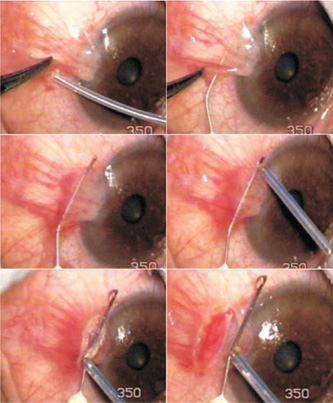
Figure 40.1. The conjunctiva is opened at the edge of the pterygium with a Fugo blade tip. A cannula injects lig- nocaine and is advanced to lift the conjunctiva. The con- junctiva is incised in a straight line over the cannula using the 600-µm Fugo blade tip.
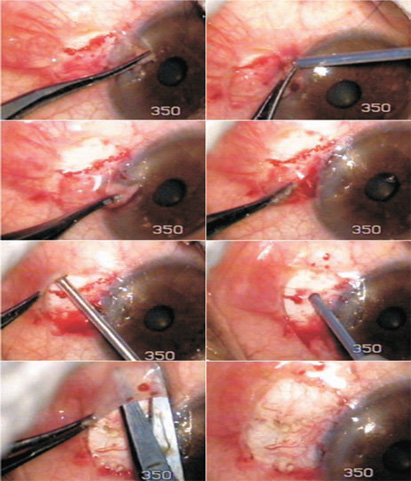
Figure 40.2. A pterygium is peeled off with partial assistance from the Fugo blade. The cut edge of the conjunctiva is undermined with the 600-µm Fugo blade tip and blunt scissors. Any bleeder on the surface of the sclera is also ablated.
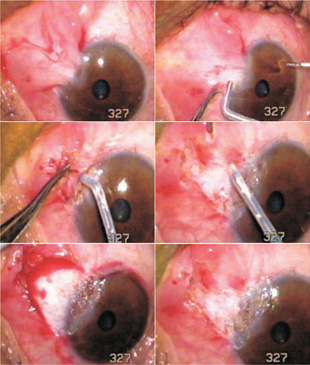
Figure 40.3. Management of a severe case of recurrent pterygium. The scar tissue has been removed with the Fugo blade and the sclera bared. The conjunctival edge has been advanced and sutured to the sclera.
Postoperative Management
Remove the pad 3 hours after the surgery. Prescribe for the patient to use antibiotic–steroid ointment three times a day for 15 days. Starting 1 day after surgery, use mitomycin 2 mg mixed in 5 ml of artificial tear drops four times a day for 7 days. The potency of mitomycin declines rapidly. This formulation of mitomycin has not resulted in any case of scleral necrosis. Only one to two re-operations a year have been done at our clinic. The rate is quite low considering that over 500 operations are done every year.
Summary
Pterygium excision with the Fugo blade results in a nice scleral surface with an intact natural pattern of blood vessels (Fig. 40.4). Together with a clean semicircular cut of the conjunctiva, they provide a very suitable bed on which to put an amniotic graft or an auto-conjunctival graft. The graft may be fixed in place with sutures or with tissue glue.
The Fugo blade is an excellent supplementary tool in any surgical approach to a primary or recurrent pterygium of any severity.
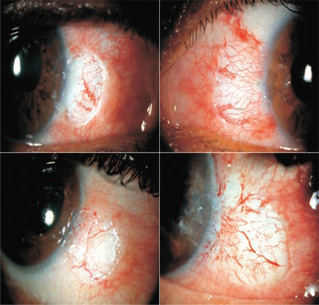
Figure 40.4. Examples of results of the bare sclera technique using the Fugo blade, 3 hours after surgery.
Stay updated, free articles. Join our Telegram channel

Full access? Get Clinical Tree


